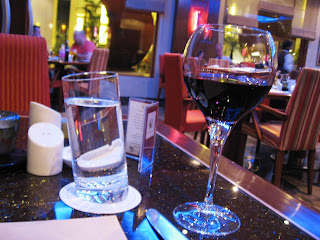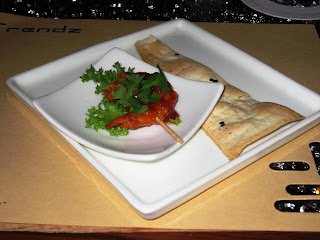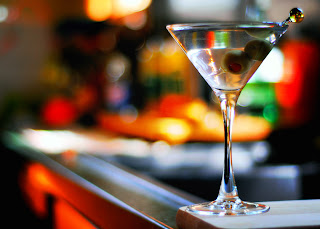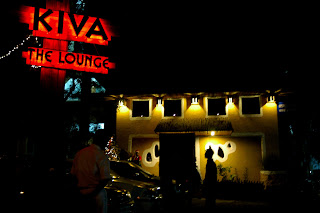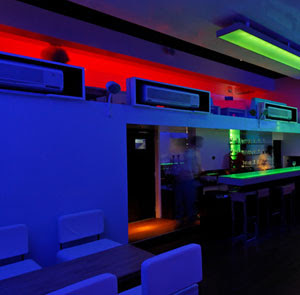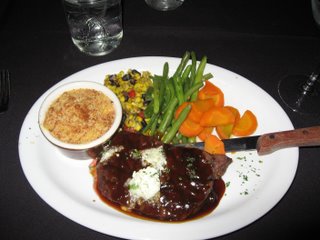
I have to admit being a newcomer to the world of steaks and steakhouses. Conditioned by my upbringing in India, I began by ordering my steaks well-done - that is, until two years back. I was at the
Moonshine Grill in Austin, Texas. The pained expression on the waiter's face when I said 'well done' made me change the order of my
Flat Iron to '
medium rare', and I have never looked back since!
Steakhouses are a revered institution in America. Catering predominantly to the male customer, these places have rarely focused the ladies. Therefore, the traditional steakhouse lacks chic interiors, variety in the menu, sophisticated side-dishes and the like. What you do get are large cuts of meat, potato sides, and warm, dark interiors.

Steaks can be pretty expensive now. It is possible to spend over $150 on your steak at dinner. To make you part with your money, upscale steakhouses have gone beyond advertising certified Black Angus or USDA Prime. Now, diners can expect customized beef: corn-fed or grass-fed; USDA Prime or the highly
marbled Wagyu beef from boutique American producers or from Japan's Kobe region; and wet-aged or dry-aged.
For the newbie, here are some basics you need to know before heading to the new, modern steakhouses:
 Dry-aged: Beef is hung in climate-controlled rooms (sometimes lined with salt) for three to six weeks, sometimes longer. As the moisture evaporates and enzymes break down tissue, the beef shrinks, the texture becomes gelatinous, and the flavor becomes concentrated.
Dry-aged: Beef is hung in climate-controlled rooms (sometimes lined with salt) for three to six weeks, sometimes longer. As the moisture evaporates and enzymes break down tissue, the beef shrinks, the texture becomes gelatinous, and the flavor becomes concentrated.
Wet-aged: Beef is vaccum-packed in plactic and ages in its own juices, for seven to 28 days. The texture becomes tender, but the flavor does not become concentrated. This is the common aging method.
Corn-fed: Cattle that spends their final months in a feedlot eating a grain-rich diet. The meat has more marbling and a richer flavor than grass-fed beef.
Grass-fed: Cattle that spends their lives feeding on grasses in pastures. The meat is often lean, cooks quickly and has a nutty flavor, though critics claim it can be tough and gamey.
Prime: The highest grade of beef awarded by the Department of Agriculture in the USA and is given to less than 2% of the meat produced every year.
 Kobe: A region of Japan famous for its Wagyu cattle.
Kobe: A region of Japan famous for its Wagyu cattle.
Wagyu (wa-gu): A breed whose meat is known for its rich flavor, exhorbitant price and exceptionally high fat content (marbling). When raised in Japan, the cattle are fed barley, wheat bran, grass and beer, their skin is massaged with sake, and their recieve little exercise.
American Wagyu: Cattle with Wagyu genes that are raised in the USA and aften crossbred with Black Angus.
The common brag on USDA Prime beef is that it's butter knife tender; Kobe beef can reach six grades higher. So tender and rich, Kobe is more like foie gras or something else of ethereal taste and texture - perhaps a truffle or some luscious nut. The key is the marbling of fat, but it's not the travertine stripes and veins we call 'marbling' in an expensive cut at the meat counter. In Kobe, the fat dots the beef thoroughly ; it looks like polished granite, not marble. When cooked, the fat melts slightly in every part of the beef.
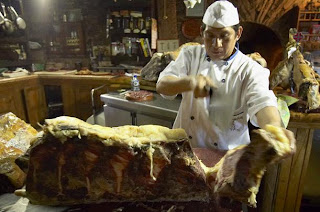 The catch is that it must be cooked quickly; even medium rare is risky. Meat this expensive deserves care at the stove, hitting hot iron just long enough to get a crisp crust like seared tuna. The chef needs to take care that the grill is perfectly hot so the beef comes away with a crisp crust and a rare interior.
The catch is that it must be cooked quickly; even medium rare is risky. Meat this expensive deserves care at the stove, hitting hot iron just long enough to get a crisp crust like seared tuna. The chef needs to take care that the grill is perfectly hot so the beef comes away with a crisp crust and a rare interior.
Even the most genetically blessed beef can turn tough if it is not treated properly. Chilling the meat immediately after slaughter triples its toughness. The ultimate steak has to be cooled gradually and then properly aged. Most importantly, it must be cooked to no more than 140ºF (60ºC), or medium rare.
This brings us to another paradox: moist raw meat means dry, tasteless steak. Fresh is certainly not best. Beef has to be hung to lose excess water, develop complex flavor, and break down tough fibers, but for how long? Experts disagree, sometimes violently!
Coming back to steakhouses in America, there are changes afoot. A new generation of celeb chefs are bucking trend with their new offerings that are architecturally stunning, female-friendly, and loaded with contemporary sides.
 Wolfgang Puck's Cut opened about two years back at Beverly Wishire Hotel in Los Angeles. With a light, airy decor, impossibly good-looking waiters in cool and casual outfits, this restaurant's popularity now rivals Puck's flagship restaurant, Spago, located just a few blocks away. Meats are grilled over wood and charcoal and finished under a 1200 degree broiler. Sexy sides includes bone-marrow flan with mushroom marmalade and parsley salad; roasted Chino Farm baby beets with French feta cheese, pistachio, citrus and micro cress.
Wolfgang Puck's Cut opened about two years back at Beverly Wishire Hotel in Los Angeles. With a light, airy decor, impossibly good-looking waiters in cool and casual outfits, this restaurant's popularity now rivals Puck's flagship restaurant, Spago, located just a few blocks away. Meats are grilled over wood and charcoal and finished under a 1200 degree broiler. Sexy sides includes bone-marrow flan with mushroom marmalade and parsley salad; roasted Chino Farm baby beets with French feta cheese, pistachio, citrus and micro cress.
Tramonto's Steak & Seafood in Westin Chicago Northshore Hotel offers 10 cuts of USDA Prime beef, both wet- and dry-aged. While prime ribs are seared in a wood-burning oven, other cuts are seared on a 1200 degree high-speed broiler. Toppers for the steaks include sliced marrow, truffled poached eggs and seared foie gras. Sides include foie gras terrine with rhubarb, red wine and strawberries; sauteed sweetbread salad with chanterelle mushrooms, pears, chestnuts, French beans and black currant vinaigrette.
Stripsteak in the Mandalay Bay Resort and Casino, Las Vegas, opened only a year back. However, this has quickly become one of Michael Mina's most profitable restaurants. Creative highlights include a unique steak-cooking method that combines slow-poaching in oil with wood-grilling; a 'Shabu Shabu' appetizer that allows customers to cook strips of Kobe beef in a hotpot of matsutake mushroom broth; and foie gras prepard four different ways.
There are many others now who let you eat steak in style. Emeril Lagasse with his Delmonico Stealhouse in Vegas to Bobby Flay and his 11000 square foot Bobby Flay Steak in Atlantic City. The trend probably began with the celebrity chef run Prime which opened at the Bellagio Hotel in Las Vegas featuring gourmet side-dishes and a view of the dancing water fountains.
Finally, a warning for some of my Indian friends: Celebrity chef Anthony Bourdain, in his bestselling book Kitchen Confidential, says the worst meat is usually reserved for those who order well-done steaks. So there!
Note: In addition to my own experiences, I have sourced information from articles in Time and USA Today (dated July 27, 2007). Pictures sourced from Time have been linked back to the original photo-essay.
 It ain't quite the French Laundry, but that's the closest I could get to this time! Like the original bouchons of Lyon after which it was modeled, world-renowned chef Thomas Keller's Bouchon serves an award-winning menu of bistro classics and daily specials, featuring the best seasonal products available. Located in the Venezia tower of the Venetian in Las Vegas, Bouchon is quite clearly the top ranking restaurant in this resort-hotel.
It ain't quite the French Laundry, but that's the closest I could get to this time! Like the original bouchons of Lyon after which it was modeled, world-renowned chef Thomas Keller's Bouchon serves an award-winning menu of bistro classics and daily specials, featuring the best seasonal products available. Located in the Venezia tower of the Venetian in Las Vegas, Bouchon is quite clearly the top ranking restaurant in this resort-hotel.  The restaurant's exquisite decor is the perfect setting for its award-winning culinary delights. Soaring ceiling, potted plants, close tables, dark-wood furniture, and Parisian murals, together result in a great ambiance. The menu was interesting: printed on a thin sheet of paper that was folded around the napkins.
The restaurant's exquisite decor is the perfect setting for its award-winning culinary delights. Soaring ceiling, potted plants, close tables, dark-wood furniture, and Parisian murals, together result in a great ambiance. The menu was interesting: printed on a thin sheet of paper that was folded around the napkins.
 I chose their specials for today: Sweet carrot soup followed by an entree of roast leg of lamb, thinly sliced and served on a bed on greens, peppers and lamb jus. For dessert I ordered the coffee infused custard. The Pinot Noir went splendidly with my lamb entree; actually, the lamb was so good, it would have been great by itself. The dessert too was smooth and creamy and a fitting end to a great meal. The Spanish dessert wine our waiter recommended was very good too!
I chose their specials for today: Sweet carrot soup followed by an entree of roast leg of lamb, thinly sliced and served on a bed on greens, peppers and lamb jus. For dessert I ordered the coffee infused custard. The Pinot Noir went splendidly with my lamb entree; actually, the lamb was so good, it would have been great by itself. The dessert too was smooth and creamy and a fitting end to a great meal. The Spanish dessert wine our waiter recommended was very good too!
 I think the sauteed scallops which some of my dinner companions turned out fine as did the cheese plattter. All in all a great evening! Everything I ate, I liked very much. The service lived up to its reputation; the waitstaff was knowledgeable, friendly and fast. Incidentally, this bistro has a great oyster bar too if you are so inclined, and they also serve a first-class breakfast in the mornings.
I think the sauteed scallops which some of my dinner companions turned out fine as did the cheese plattter. All in all a great evening! Everything I ate, I liked very much. The service lived up to its reputation; the waitstaff was knowledgeable, friendly and fast. Incidentally, this bistro has a great oyster bar too if you are so inclined, and they also serve a first-class breakfast in the mornings.










